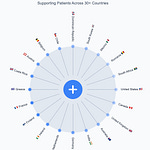Gary Wolf coined the term quantified self in 2008 along with former Wired editor Kevin Kelly when they noticed that technology was making it easier for individuals to record and study themselves.
Soon a series of regular quantified self meetups began to spring up, first in the Bay Area but eventually all over the world. Worldwide conferences attracted thousands of like-minded individuals and spawned the development of dozens of successful products such as Fitbit and Oura Ring.
The Quantified Self is an international community of people who use self-tracking tools and share an interest in “self-knowledge through numbers.” Quantified self experiments can track many different types of health data such as mood, sleep, weight, step count, blood sugar, cholesterol levels, symptom severity, heart rate variability, and microbiome composition.
While the quantified self movement began with a focus on optimizing performance and general wellness, it has evolved to become particularly valuable for patients with complex chronic conditions. This evolution represents a shift from fitness tracking to illness monitoring and management.
Health tracking isn’t just for longevity-obsessed billionaires.
It can also help patients monitor and manage disease.
Getting Started
The basic approach to quantified self experiments provides a powerful framework for chronic illness management:
Decide what you want to observe. For chronic illness, this means identifying not just primary symptoms but also potential triggers, treatments, and quality-of-life factors that fluctuate with your condition.
Make sure your observations are relevant, consistent, & trustworthy. With chronic illness, consistency becomes crucial. Logging at similar times each day, using clear rating scales, and being honest about activities all contribute to more useful data.
Collect data and record observations. Apps like Visible and Bearable can significantly reduce the burden of this step, making it possible to track even on difficult days when symptoms are flaring.
Consolidate your insights. The true power of self-tracking emerges here, as patterns reveal themselves over time, empowering more informed decisions about activities, treatments, and lifestyle changes.
Symptom Pattern Recognition
For patients with complex conditions, identifying symptom patterns can be challenging due to the multifaceted and protean nature of our illnesses. Health tracking applications help overcome this challenge by:
Enabling comprehensive tracking: Apps like Bearable allow users to track symptoms, treatments, and environmental factors that might affect their health.
Visualizing correlations: These tools generate reports that reveal relationships between symptoms and potential triggers that might otherwise go unnoticed.
Reducing cognitive burden: By providing a structured framework for data collection, digital health tools reduce the mental load associated with remembering and connecting experiences over time.
Pacing and Energy Management
Many chronic conditions involve limited energy reserves and post-exertional flares. Health tracking tools help patients optimize their energy expenditure through:
Real-time monitoring: Apps like Visible use wearable technology to provide immediate feedback on physical exertion levels, helping users stay within their safe zone.
Establishing baselines: By collecting consistent data over time, patients can establish their personal thresholds and recognize early warning signs of overexertion.
Proactive pacing strategies: With better understanding of energy patterns, patients can implement preventative pacing rather than reactive rest.
Medical Collaboration and Diagnosis
Health tracking tools bridge the gap between episodic medical appointments by providing objective data that can enhance clinical decision-making:
Enhanced communication: Patients can share detailed health reports with providers, offering a more comprehensive view than basic symptom recall.
Diagnostic insights: Patterns revealed through consistent tracking can provide clues for diagnosis, especially for conditions with subtle or fluctuating symptoms like dysautonomia, which affects heart rate, blood pressure, and digestion.
Treatment evaluation: Systematic tracking before and after interventions like ivabradine provides objective measures of treatment efficacy.
Honor Your Limitations
The goal of self-tracking is to improve quality of life, not become another burden. Adapt your approach to accommodate fluctuating abilities:
During periods of remission, you might track more detailed metrics
During flares, focus only on essential data points
Use voice memos or simplified logging methods when energy is limited
Remember that imperfect data is still valuable, and consistency matters more than perfection
If you’d like to learn more about different health tracking tools, check out the Digital Health/Symptom Tracking section of the Spooniverse Directory!










